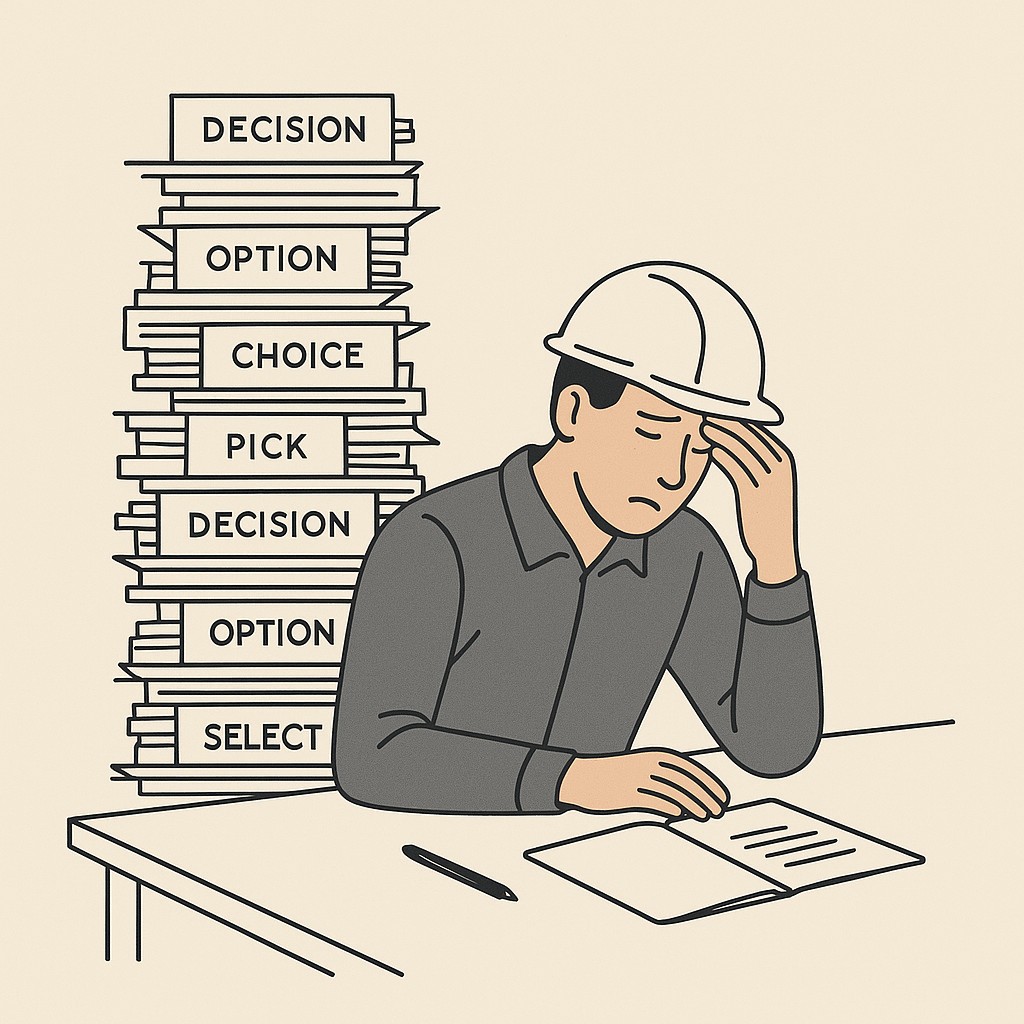Improve engineering decisions with AI: Your judgment, unburdened
Improve engineering decisions with AI: Your judgment, unburdened

Your Judgment, Unburdened
I’ve learned the hard way. Decisions pile up as fast as code. If you’re building anything decent, you spend half your time choosing paths, not just writing endpoints. The grind sneaks up on you, until one morning you realize you’re not just tired. You’re threadbare, making calls under pressure and hoping you’re not missing something that’s going to spiral later.
What shifted for me wasn’t fancy. Six months ago, I began to improve engineering decisions with AI by running it in parallel on my actual engineering forks. I’d just log the outputs, compare the options, but hold back on deploying. I wanted coverage, not risk. If the extra input nudged me in a better direction, great—if not, nothing lost and no production surprises.
You know what it’s like. These aren’t binary choices—they’re constant balancing acts. Rolling out a feature now or waiting for another test. Picking which partner system gets the next integration. Tweaking a pipeline, chasing a perf win, juggling “urgent” asks. To reduce engineering decision fatigue, recognize how it creeps in quietly—the kind that warps what you think is good judgment. Suddenly you’re deferring little things (“I’ll refactor later”), or pushing through half-baked logic just to be “done.” It stacks up and slows the work. I still catch myself dodging minor cleanups just because my brain is fried.

That’s where AI decision support has become my decision sidecar. Not a decider, not handing over the wheel. Just a steady, structured sounding board. The whole point is to keep your judgment at the center, but widen the surface area of what you can see. More options, sharper critique, but you’re the one steering. It’s not about automating away judgment, though I used to think it might be. It’s a way to keep that edge when you start to haze out.
The sidecar maps the terrain through tradeoff analysis with AI. Options, tradeoffs, risks. Three different rollout strategies laid out—some I probably wouldn’t have considered when the deadline fog rolls in. Vulnerabilities flagged upfront. It structures the choices, so you’re not mentally juggling fragments of specs and half-memories of caveats. Alternatives get laid flat and easy to scan. Not every AI output hits, but even the logged misfires cut down on the background hum. You back up, scan the map, move faster, keep your judgment clear. If you’re worried about drift or rogue suggestions, keeping the sidecar limited to review mode lets your calls stay yours, just better informed.
The Smartest Place to Start
If you’re anything like me, you want quick results with zero risk. The lowest-friction start is the tiny stuff—choices that sap energy but won’t blow up if the AI bombs. Cutting down the cognitive load gives you slack to judge well—even minor offloads improve focus and tamp down bias. Back when I started, I didn’t want a revolution. Just a couple easy wins to clear my head.
The best candidates? Naming variables, spitting out boilerplate comments, lint config, skeleton files. Trivial solo, but in a herd, they quietly gnaw at attention. Years back, I’d burn ten minutes debating what to call a utility module. Now, I nudge AI to spit out options, pick the one that feels clean, and move on. That “starting point” shortcut means I’m primed for design work, not distracted by pickiness. One offload led into another. Soon my brain came back to the real decisions, not the repetitive set-dressing.
Mechanics are simple. Prompt the AI for a couple choices, set hard boundaries (“don’t touch critical files”), skim fast. Never blind trust. I keep a short log to see what I actually take versus toss, and watch for patterns that save hours down the line.
You ship faster, meet deadlines, keep standards high. Speed isn’t stealth cuts—it’s scrubbing the noise so judgment stays on track.
Synthesize, Stress-Test, and Improve Engineering Decisions With AI
Once you’ve seen the sidecar work on small stuff, it’s time to use AI for technical tradeoffs with structured passes on real choices—before anyone else even weighs in. Not a handoff, but a parallel brainstorm in a sandbox. I ask for a couple alternatives, log the output, vet each one myself. Every switch or tradeoff gets real consideration, but I keep the final vote. No tossing the whole thing to a bot—more like expanding the options menu without touching anything yet.
Here’s how it usually runs. Now, when I hit a feature fork or sticky integration, I improve engineering decisions with AI by having it lay out two ways forward, with pros, cons, and actual weak points. I want explicit tradeoffs and failure modes. Not hunting for the magic fix—just peeling back the cover so I can spot hidden flaws faster. Even in tough calls, most folks ignore system advice or keep their hand on the wheel. So it’s not about giving up judgment; I’m powering up how I deliberate.
It’s a weird parallel, but last fall I found myself comparing engineering decisions to picking routes on climbing days. On a cold morning, staring at three possible lines, you walk each approach mentally before putting boots to rock. Look for loose scree, test holds, picture where a slip costs more. Engineering forks work the same. If you rehearse failure points, know where it breaks, you’re likelier to choose well—maybe with scraped shins, but not a busted route. Small tangent, but I blame too many weekends at Red River Gorge.
Anyway, you can sniff blind spots early by running a pre-mortem. I’ll straight up ask AI, “How does this plan fail? What cracks if the deadline shifts? Mitigations—cheap or risky?” The breakage-oriented prompt is gold—forces design to show its soft underbelly. Sometimes all I get is a dumb suggestion, but sometimes it flags that a fallback won’t scale, or a retry loop that’s brittle if the network lags. If you see the failure modes clean, you tweak before sharing, keep patches cheap. No postmortems after launch—you and the sidecar run the stress early, act before anyone else’s hair is on fire.
Clear line: human decides, model broadens perspective, lowers mental drag. AI doesn’t replace judgment. It widens your lens, lets you scan more ground and call the shots from a bigger map. Just leverage, not autopilot.
Delegate, Monitor, Improve: Practical Automation Without Losing Control
First, you need to know which flows to automate and which to keep close. Anything repeatable, friction-heavy, and needing consistency—triage, routing, threshold checks—goes to the sidecar pile. Don’t just hand them off and hope. Delegate but log everything. Reasoning, outcome, every path taken. Later you’ve got a trail to audit, tune, or just double-check that logic holds up under a harder look. I use this for incident triage, threshold alerts, repetitive checks—the kind of loops where fatigue snuck in small mistakes.
Oversight? Shadow mode, then partial release. At first, flow runs but human review stays tight. I log every decision, flag deviations, set alerts for oddball outputs. Human override never leaves the table. Only after weeks of clean logs do I promote flows to “on”—and still, tune as I go. The logs become evidence, not just busywork. They show where the process slipped, where manual checks mattered, and where it proved itself.
I’ll say it: I worried this would suck more time than it saved. Thought I’d end up building scaffolding just to automate a small thing. I picked my worst repeat offender—review checklists for config updates—and ran a fast pilot. What happened? The most brain-numbing bits vanished; review time dropped. Context switches eased; decisions sped up. Skepticism melted once the hours stacked up. Faster payoff than I’d guessed.
Quality isn’t perfect; hallucinations happen. So I lock it down hard. Inputs tight—the model gets only what’s needed. Output must explain itself. Why pick A over B, paired logs or references. No “just trust me.” Compare to a golden set if you can, and nothing goes through until you greenlight. This stays firm—if a flow can’t lay out clear reasons, it stalls. No quiet failures, no magic answers.
Sticking to constraints sets you up for scale later. Velocity stays high, options broad, costs lean. When growth finally comes, you’re ready to expand with real flows, not a brittle tangle you have to rebuild top-to-bottom. The wheel stays in your hand, not rolling away with a rogue bot. Move fast, but leave room for what’s next.
Step In, Level Up: Grow Decision Coverage Without Losing Control
I split up adoption for AI-assisted engineering decisions across five clear steps. First, offload micro-decisions—the tiny repeats that chew focus. Second, run AI in parallel, log what it says, but keep the wheel. Third, move up to option synthesis: prompts that force the sidecar to present alternatives, surface pros, cons, and breakpoints. Fourth, rehearse each critical choice with scenario prompts (“Walk me through how failure hits if we swap A for B”) before settling your call. Last, take a swing at observability-first automation for the most mind-numbing flows—let AI handle the mechanics, but put human hands at the final approval gate. It’s fine to crawl. I care more about wide coverage and real evidence before flipping any live switches.
Progress needs proof, not hope. Track decision latency, rework rate, incidents, throughput, but my gold metric—reviewer time saved. Logging this tells you the system’s easing drag. Fewer “urgent pings” and last-minute scrambles? That’s a win worth calling out.
It’s about more than just clearing the deck at warp speed. The sidecar widens what you can see so your judgment rests on broader ground, grinds less against mental noise. That’s the win. Calls made sharper, even when pressure hits harder.
Get clean engineering docs, changelogs, or posts without the drag; generate AI-powered content fast, guided by your goals, constraints, and tone, while you keep your judgment squarely in charge.
Try it now, not next quarter. Treat AI as pure decision leverage—never as a decider. Start small, keep your grip tight, expand only as the evidence lines up. I still haven’t squared letting go of the wheel completely. Maybe that never happens. But if the field is wider, and the calls get cleaner, I can live with tension at the edge.
That “surface area” piece from before? It’s what I keep coming back to. Widen the field, stay in control. Ship sharp, not scattered. That’s how I keep moving forward—pace, judgment, and sanity all (mostly) intact.
Enjoyed this post? For more insights on engineering leadership, mindful productivity, and navigating the modern workday, follow me on LinkedIn to stay inspired and join the conversation.
